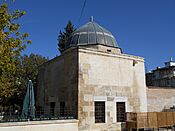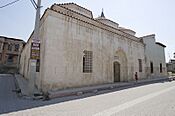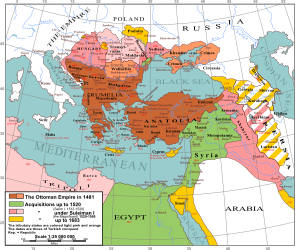Ramadanid Emirate facts for kids
Quick facts for kids
Ramadanid Emirate
Ramazanoğulları Beyliği
|
|||||||||
|---|---|---|---|---|---|---|---|---|---|
| 1352–1608 | |||||||||
| Status | Protectorate of the Mamluk Sultanate (1352-c.1397) De facto independent (c. 1397–1517) Protectorate of the Ottoman Empire (1517-1608) |
||||||||
| Capital | Adana | ||||||||
| Common languages | Turkish, Armenian, Arabic, Syriac | ||||||||
| Religion | Bektashi, Christianity (Armenian Apostolic Church, Syriac Christianity), Islam | ||||||||
| Government | Emirate | ||||||||
| Bey | |||||||||
|
• 1352
|
Ramazan Bey | ||||||||
|
• 1608
|
Pir Mansur Bey | ||||||||
| Historical era | Early Modern | ||||||||
|
• Established
|
1352 | ||||||||
|
• Disestablished
|
1608 | ||||||||
|
|||||||||
The Ramadanid Emirate (in Modern Turkish: Ramazanoğulları Beyliği) was a self-governing state. It acted like an independent country from 1352 to 1608. This emirate was located in a region called Cilicia. It took control of the area from the Armenian Kingdom of Cilicia.
At first, the Ramadanid Emirate was protected by the Mamluk Sultanate. This lasted until the late 1300s. After that, it was truly independent for over a hundred years. Then, starting in 1517, it became a protectorate of the Ottoman Empire. The main city and capital of the emirate was Adana.
The Ramadanid Emirate was special. It was the only emirate in Anatolia that did not come from the Anatolian Seljuk Sultanate. People sometimes wrongly call it an Anatolian beylik. However, it was actually a state under the Mamluks. Cilicia was part of the Seljuks for a short time around the 1000s. This meant it was not much affected by the spread of Sunni religious groups in the 1200s. In the late 1300s, the Yüreğir Turks moved to Cilicia. They had their own unique culture. It included influences from Bektashi traditions and some shamanic rituals, along with Islam.
Contents
History of the Ramadanid Emirate
How the Emirate Began
The Mongol invasion of Asia caused many Oghuz Turks to move. They migrated into Anatolia and the Levant. A Turkish tribe from Yüreğir in Transoxiana settled in the northern parts of the Mamluk Sultanate. This was allowed by the Sultan. They settled from Antioch to Gaza. These people were known as Türkmens or Yüreğirli. This means "from Yüreğir."
The Ilkhanate empire became disorganized after its leader, Abu Sa'id, died. Because of this, it could not help the Armenian Kingdom protect Cilicia. Also, there were fights within the Armenian Kingdom itself. These problems made the Türkmens look towards Cilicia. They saw it as an unstable place they could take over.
In 1352, a leader named Ramazan Beg led the Turkmens. They settled south of Çaldağı. They founded their first town, Camili. Later that year, Ramazan Beg went to Cairo. The Sultan there agreed to let him create a new frontier Turkmen Emirate in Cilicia.
The Yüreğir Türkmens lived as a small group for seven years. They were in the southeast of Adana. They named their new land Yüreğir. In 1359, the Mamluk Sultanate Army marched into Cilicia. They took over Adana and Tarsus. These were two important cities in the plain. They left only a few castles to the Armenians.
In 1375, the Mamluks took control of the rest of Cilicia. This ended the Armenians' rule, which had lasted for three centuries. The Mamluk Sultanate allowed the Türkmen Emirate, led by Ramazan Beg, to manage Cilicia. However, the Mamluks kept direct control of some towns. These towns were Tarsus, Ayas, Sarvandikar, and Sis. These were at the four corners of the Cilicia plain. For each town, they appointed an Amir (a leader) and a Garrison (a military group). Tarsus, which used to be the capital of Cilicia, was settled by people from Egypt. The Türkmen Emirate, which became known as the Ramadanids, made Adana their main city. Many Türkmen families from Yüreğir moved to Adana.
Conflicts and Alliances
After Ramazan Bey died, his son Ibrahim Bey became the new leader. Ibrahim Bey made an alliance with the Karaman Emirate. Alaeddin Bey and Ibrahim Bey worked together. They tried to remove the Mamluks' control from the province.
After this alliance, a large Mamluk army moved in. They started to plunder the area. But Ibrahim Bey's army won a great victory against the Mamluks in Belen. In this battle, Temur Bey, a Mamluk general, was captured. Yilboga, the amir of Aleppo, then moved against the Turkmens after this defeat. He conquered Misis Castle.
The Ramadanids were very important in the 1400s. They played a key role in the relationship between the Ottomans and the Mamluks. The Ramadanid Emirate was a buffer state. This means it was a neutral area between two larger powers. It was located in the Mamluk frontier zone called al-'Awasim.
End of Independence
In 1516, Selim I, the Ottoman Sultan, took over the Ramadanid Emirate. This happened after his conquest of the Mamluk state. The leaders, or beys, of the Ramadanids continued to manage the Ottoman sanjak (a type of district) of Adana. They did this in a family line until 1608. For the last 92 years, they were vassals of the Ottomans. This means they ruled under the Ottomans' authority.
Buildings and Architecture
The Ramazanoğlu Hall is a famous building from this time. It is still used today as a cultural center. It was once the main residence for the leaders of the Principality. The original administration hall of the Principality no longer exists.
Leaders of the Ramadanids
Here are the leaders, or Beys, who ruled the Ramadanid Emirate:
- Ramaḍān (1353)
- Ibrāhīm I (1378–1383)
- Shihāb al-Dīn Ahmad (1383–1416)
- Ibrāhīm II (1416–1418)
- ʿIzz al-Dīn Hamza (1418–1426)
- Meḥmed I (1426–1435)
- Eylük (1435–1439)
- Dündār (1439–1470)
- ʿUmar (1470–1485)
- Ghars al-Dīn Khalīl (1485–1510)
- Maḥmūd (I. 1510-1514- II. 1516–1517)
- Selīm (1514–1516)
- Qubādh (1517–1520)
- Pīrī Mehmed (1520–1568)
- Darwīsh (1568–1569)
- Ibrāhīm III (1569–1589)
- Meḥmed II (1589–1594)
- Pīr Mansūr (1594–1608)






